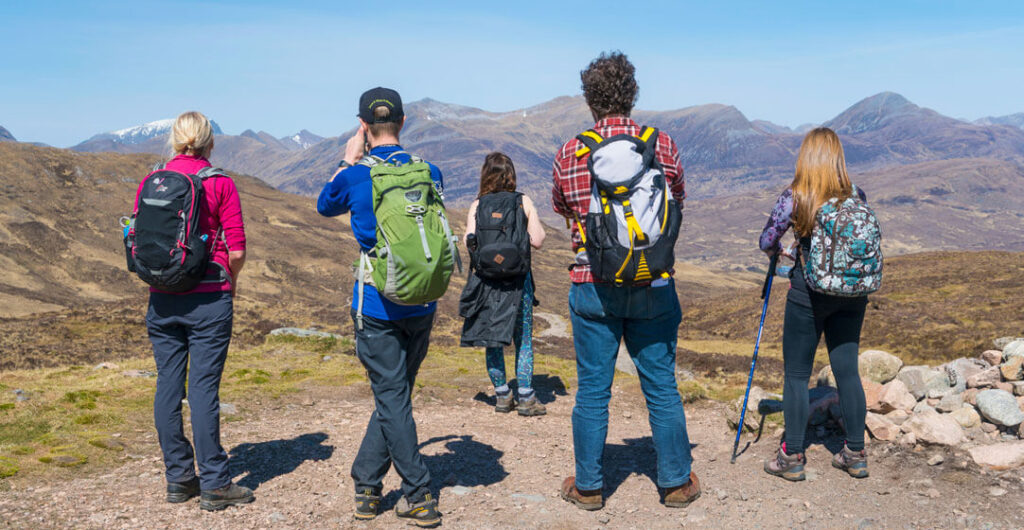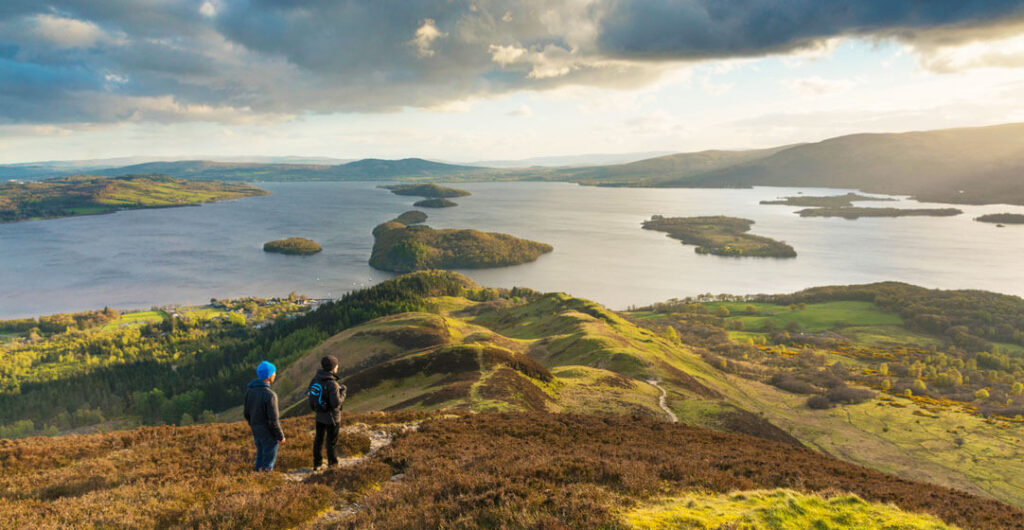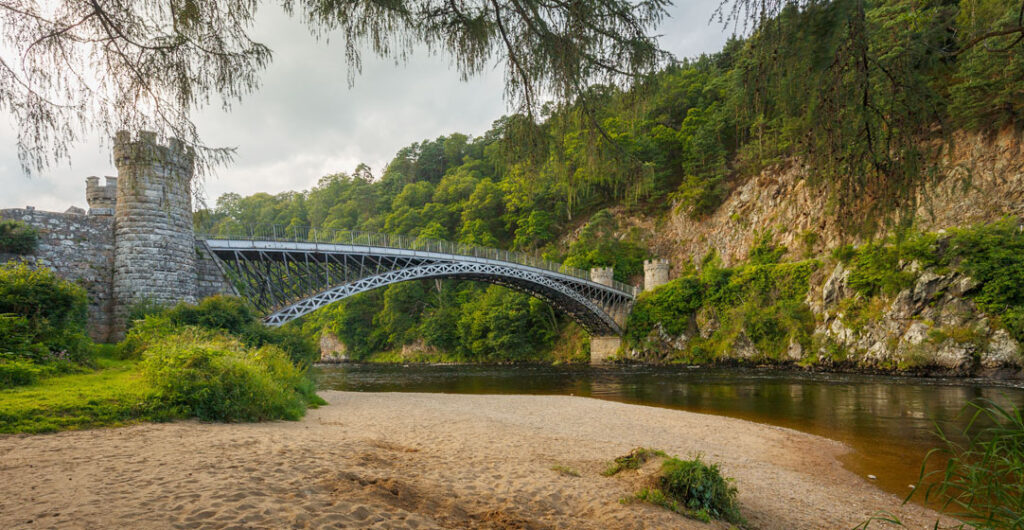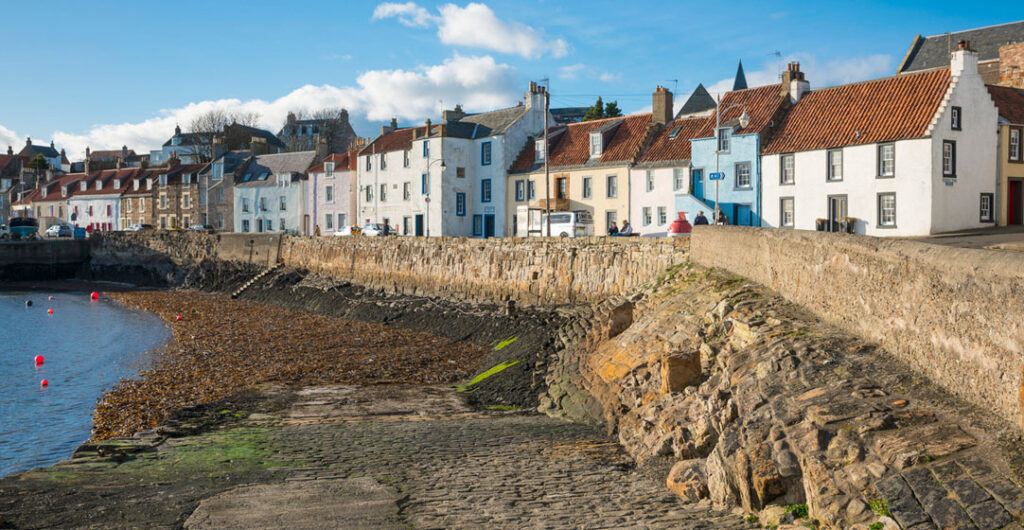See a majestic land along famous walks on a hiking Scotland vacation
By Mike Nolan, Special to AAA Washington
Scotland usually brings to mind images of bagpipes, plaid kilts, haggis and Scotch whisky, but my mental picture expanded after spending a month there. Walking—with lovely paths, varied scenery, and friendly trail companions—is now at the top of my list.
My partner, Ann, and I decided to hike Scotland last spring (we say hiking, they call it walking). We gave ourselves a month to get to know the countryside and its people. During our research, travel websites directed us to Scotland’s most famous routes—there were several to choose from. We picked four geographically unique walks: the West Highland Way (the most popular walk in the United Kingdom), the Great Glen Way, the Speyside Way and the Fife Coastal Pathway. All these walks are “dog friendly,” in case you travel with your favorite canine.
These four trails provided the best way for us to see Scotland, offering such diverse scenery that we never tired of it. That’s not to say we never got tired. Our first trek, in the Scottish Highlands, had sections that were physically demanding. But we paced ourselves and, by booking our lodgings ahead of time, knew we had a place to stay when days grew long.
AAA Travel Tip: Interested in hiking Scotland? Consider a group tour. Club Adventures by AAA’s Classic Walks of Scotland 6-day tour offers a sampling of some of Scotland’s best walks like the West Highland Way and the Great Glen Way, with expert guides by your side. Ask a AAA Travel agent about this tour and many more across Scotland.

Hiking Scotland: West Highland Way
Scotland’s first cross-country walking path—a 95-mile trek from Milngavie to Fort William—features a variety of terrain: mountain paths, forested walkways and lakeland trails. It is often “hill and dale” walking, scaling peaks such as the breathtaking Conic Hill or the even more demanding Devil’s Staircase.
Chances are good you’ll make friends on this walk. People stop to rest at different times: You’ll pass folks who may later pass you and soon you’ll develop a nodding acquaintance. When you stop at the end of a day to refresh yourself over a pint, conversation follows.
“I’ve lived in Glasgow all my life—born and bred there,” one woman told us, “and I’ve heard about the West Highland Way as long as I can remember. I’ve always wanted to do this walk, and I finally got my chance!”
Ann and I walked alongside her for four days, stopping at the same small villages, discussing the trail and sharing a pint each evening.
Whether on the trail, at a bed-and-breakfast or in a pub, I was struck by how outgoing the Scots are. “Hi ya” is the common greeting, coming from solo walkers, groups of hikers, folks walking their dogs, or trail runners.
In reserving our accommodations, we parceled out the hike into legs ranging from 7 to 15 miles, depending on the type of terrain we faced and the elevation gained, giving us eight days to complete the trip. Throughout that week our constant comment was “The views are spectacular,” followed by “I understand why the late Queen Elizabeth II made the Scottish Highlands her country getaway.”

The most challenging leg for us was the section of trail skirting Loch Lomond. Along most of the lake, the path hugged a steep shoreline, up and down, which made for slow going (did I mention that rain made the trail wet and slippery?). Scrambling over roots, rocks, branches and boulders, we covered over 14 miles that day, but it took us almost 10 hours.
Beyond Loch Lomond we encountered hilly terrain with relatively flat, pastoral stretches in between. Our hike took us along stone fences separating gently rolling sheep pastures and through kelly-green patchwork farmland, with exquisite lakes far in the distance. Mountains on the horizon seemed to touch the clouds. Along the way, Scotland worked its magic on us: Ann and I felt uplifted and inspired.
We could see our journey winding down as we traversed Glen Nevis and approached farms, then country houses, and finally city streets—all with Ben Nevis, Britain’s tallest peak, looming in the background. Wrapping up our trek in downtown Fort William, we massaged weary feet and beamed triumphant smiles.
AAA Travel Tip: Whether you’re interested in hiking Scotland from end-to-end or simply walking a historic trail for a day, there’s a Club Adventures by AAA group tour for you. Chat with a AAA Travel agent to learn more about exploring the Orkney Islands, Isle of Skye, Cairngorms National Park, Shetland Islands and beyond. There’s even a group tour custom-built for visiting Scotland with teens.

Hiking Scotland: Great Glen Way
The Great Glen Way begins where the West Highland Way ends, at Fort William, and follows lakes and canals for 72 miles to Inverness. With Fort William fed by the Atlantic Ocean and Inverness greeting the North Sea, the Great Glen’s waterways bisect northern Scotland, technically turning the Northwest Highlands into Scotland’s largest island. The excursion is suitable for boating in the waterways or hiking or bicycling along the trail, so we decided to make this a canoe trip and rented a tent, camping gear, and canoe with a portable trolley.
Canoeing pristine highland canals that connected expansive lakes—including Loch Ness—we negotiated changes in elevation through a series of locks (over two dozen in all), which we portaged around using our trolley. We would approach a lock, dock the canoe, unload it, then pull it up on shore and mount the trolley. After we filled the canoe back up, we’d trundle the craft around the locks, providing entertainment for anyone else cruising down the waterway. Somehow, we always managed to portage our canoe when someone was moored or motoring close by, usually people in pleasure craft.
One outgoing captain saw us and waived, while a couple of passengers in plush, comfortable deck chairs offered words of encouragement, with one hollering out, “How are you doing?”
As Ann and I labored our canoe over the portage and around the lock, I raised both hands in a show of exasperation.
They shouted back, “Did you bring something to drink?” To which Ann replied, “Not enough!” Everyone laughed.
Then, before we could put our canoe back in the water, someone scrambled below deck, emerged with a bottle of wine, hopped off the boat, and brought it over. That stopped Ann and I in our tracks.
“That’s so nice. Thank you,” Ann said. “White wine… chilled, even!”
“Bon voyage!” they told us. “Where are you heading?”
“Inverness.”
“Us too. We’ll watch for you.”
They motored onward and we decided this was a good time to break for lunch and enjoy some wine.

The canals and lakes were beautiful from our canoe, but our ladened craft felt skittish, and when the wind came up, getting swamped or overturned became a concern. At one portage, we spoke to some kayakers who gave us a weather report: high winds and high waves expected on the lake.
At the next set of locks, we conferred with a lock master, who told us that he expected whitecaps ahead on Loch Ness—waves far too challenging for our low-riding, heavily loaded craft. “The wind can whip down the valley sides and kick the waves up a meter or two, and it’s forecast to last three days,” he said. “I doubt the lock master at Loch Ness would allow small craft to go through.”
We changed our plans and arranged a ride into Inverness, returning our canoe. Over the next couple days, we walked along the canals and biked the lakeside trails, covering the parallel distance we would have canoed. Biking along the shoreline, I was impressed by the size of Loch Ness: 28-miles long and 788-feet deep
AAA Travel Tip: Before any international vacation, it’s a good idea to get some local currency. AAA Washington can help. You can order foreign currency from Wells Fargo at any AAA Washington store. The fee is $5 for AAA members and $20 for nonmembers. For your hiking Scotland trip, you’ll want Pounds Sterling (GBP).

Hiking Scotland: Speyside Way
The Speyside Way, or Speyside River Trail, is an 80-mile walk from the village of Buckie, on the Coast of Moray, to the town of Aviemore. This is an attractive, mostly flat walk through woodsy areas and distinctive villages. It’s also known as the “Whisky Trail,” so if you happen to enjoy single malt Scotch whisky, you’ll find a number of Speyside distilleries that welcome visitors and offer tours. Many are accessible right along the trail.
Ann and I decided to mix walking with distillery touring, hiking alongside the River Spey in the early hours and participating in distillery tours after lunch. By committing to a strenuous morning walk, we felt we earned the leisure of a tour, as well as a sampling afterward.
During our hike, we experienced a variety of landscapes: forested areas, sleepy villages, working farms and estates. Of our four treks, Speyside was the least crowded. We met other walkers occasionally, but mostly connected with fellow travelers on the distillery tours (reservations recommended). With something like 50 distilleries in the Speyside region, we came across world-famous brands alongside obscure labels completely new to us.
We participated in four tours. All covered the same basic process of mashing, fermenting, distilling and oak barrel aging, but each offered something unique. Our tour guides educated us about what makes their particular single malt different and included historical references and entertaining observations, showcasing the Scottish personality. While I expected the demeanor so often stereotyped and parodied—dour, tightlipped, parsimonious—we found the exact opposite. In fact, individuals leading the tours used that stereotype as a jumping off point for humor.
Referring to a distillery byproduct—spent grains—one guide explained, “We sell it for livestock feed, which makes the cows happy, and us happy. We don’t throw anything away, you know… we’re Scottish.”
Another guide highlighted a particular step in their distillation process by saying, “We found this step not only enhanced the flavor of our scotch but also saved us a few cents a barrel. Of course, being Scottish, this appealed to us.” There was something comforting in finding the time-worn distillation process, even when enhanced by a bit of modern technology, still retaining a very personal, hands-on feeling.
AAA Travel Tip: Many group tours of Scotland include a Scotch distillery tour or two. Ask a AAA Travel agent about tour options that include transportation and personalized experiences, plus tips for destinations with the best hiking in Scotland.

Hiking Scotland: Fife Coastal Path
This scenic walk covers 116 miles of spectacular coastline in the Fife Council area on Scotland’s eastern seaboard. Beginning in Kincardine on the Firth of Forth (“firth” is Scottish Gaelic for “estuary”), the walk ends at Newburgh, on the Tey Estuary. Golf aficionados know St. Andrews, considered the home of golf, is located along the route, and walkers will also encounter quaint seaside towns and fishing villages—not as well known but charming nonetheless.
Along with its historic golf course, the university town of St. Andrews boasts architecture that exudes old-world charm. Ann and I began our walk here, meandering through town, then turned toward the coastline. We hiked along wide golden beaches and over rocky peninsulas strewn with dark green seaweed, all bordered by the majestic buildings of the college campus. We made our way to Saint Monans, a small harbor village, where we discovered a 14th-century church and, a little farther down the trail, the remains of Newark Castle, its ancient ruins looking out to sea.
The path snaked along the shore, affording wonderful views from stone breakwaters and wooden piers. It’s remarkably beautiful, rugged but welcoming.
Some of the local population still work the fishing trade, as evidenced by working crafts of all shapes and sizes in the harbor. We maneuvered around ropes, buoys and nets stung out along the docks, as well as heaps of lobster traps stacked on the piers.
Our explorations took us past old stone churches and watchtowers on our way to spots like Aberdour Castle and Macduff’s Castle. And all along the way, we crossed paths with day hikers, couples, parents with small children—random encounters that were consistently personable.
For us, walking was the perfect way to see Scotland and connect with Scottish people.
Looking back, Ann and I did see plaid kilts (in Edinburgh tourist shops), ate haggis at more than one country pub, and certainly enjoyed a dram or two of single malt whiskey. However, it was the scenic pathways—and the Scots we met traversing them—that stand out as most memorable, and now represent Scotland to us.

—Written by Mike Nolan
—Top photo by Kenny Lam/Visit Scotland
AAA Travel Tip: Interested in hiking Scotland? Chat with a AAA Travel agent and get expert help planning an incredible vacation.

Travel Planning Tips
Get expert advice: Your perfect getaway awaits. No matter what destination you choose, or how you wish to travel, AAA Travel experts can help you plan a perfect experience that you will remember for years to come.
Purchase travel insurance: Protect your trip investment with travel insurance.
Consider Concierge: AAA’s Concierge Vacations feature done-for-you details and special amenities for travel to world-wide destinations. AAA Travel Agents will make your planning a breeze and your vacation unforgettable.
On the road: Get ready for every trip with a AAA Membership. Get peace-of-mind on the road and much more.
Save with discounts: AAA membership gives you access to exclusive discounts nationwide.









